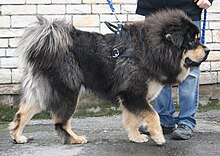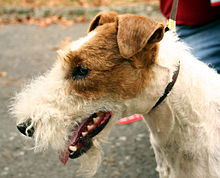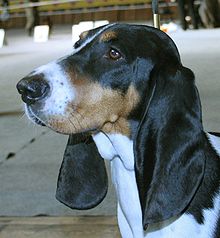List of cynological terms
Cynological terms that appear in connection with dogs or dog breeding often have a very special meaning, which in many cases deviates from the everyday meaning. For example, “dry” does not mean the absence of moisture, but refers to the appearance or a property of the skin. Such technical terms are often incomprehensible or misunderstood for laypeople, but they make communication between experts easier. Their origins are often far in the past. Many come from English, as targeted breed breeding began in England. Due to the widespread use of hunting dogs, there is also some overlap with the hunting language .
A.
- Marks: regular and irregular spots in the fur
- AKC ( American Kennel Club ): largest dog breed association in North America
- Apple head: round, apple-shaped upper skull shape, such as that of the Chihuahua
B.
- Feathering: long hair on ears, chest, legs and tail
- Ears: drooping ears, typical of some hunting dogs
- prove: let the bitch cover
- Belton: Color name for a stippling and / or a confluence of colors in the fur of the English Setter
- Sooting: see charbonnage
- Black eye ( Heterochromia iridis ): differently pigmented areas of the iris, the unpigmented ones appear white; often in spotted dogs such as Dalmatians, Great Dane and Merle-colored dogs
- Black and Tan ( coat color ): Black and tan
- Blue ( fur color ): anthracite gray to steel blue, due to the dilute gene
- Blaze : white stripe on the forehead
- Brachycephaly : short snout compared to the skull
- Brand : in dark-colored dogs, the lighter markings on the eyes, muzzle and underside of the body
- Bow joint: shoulder joint , the foremost point of the chest and therefore an important point for measuring the length of the torso
C.
- Charbonnage, also sooting ( coat color ): The individual, lighter hairs have a black tip, which gives the impression that you have stroked the dog's coat with a sooty hand.
D.

Dolichocephaly with a Borzoi
- Mating act: mating
- Blanket: related to coat colors, the color all over the back
- mating: mating
- Top coat : fur, which determines the color, usually longer than the undercoat (if it is present)
- Dolichocephaly : compared to the skull, the snout is longer, especially in collies and greyhounds
- Wire hair: short, hard outer hair, usually with a beard on the muzzle
F.

The flag and feathers of an Irish Red and White Setter
- Fah: female fox or wolf
- Flag: long drooping hair (especially on the tail, but also on the limbs or ears)
- Tracking : the "footprints" left on the ground (see also mantrailing )
- Muzzle: dog's snout
- FCI ( Fédération Cynologique Internationale ): the leading dog breeding association in continental Europe , Latin America and parts of Asia
- Feathers: feathering, half-length, fringed hair on the legs
- Wrong color : coat color not provided for in the breed standard
- Field Trial : a hunting test for dogs in which they retrieve game
- Figurant (false perpetrator): Helper in protection dog training and in the mondioring , in padded protective clothing after an attacker
- Flanks : lateral abdominal region
- Bat ears well set and correctly placed (e.g. French bulldog, Chihuahua)
G
- GAIT / MOVEMENT: The dog's way of moving, mostly at a trot
- Build: the physique of the entire dog
- Bells: Barking of the hunted hounds
- brindle ( coat color ): darker horizontal stripes on a lighter coat, similar to the tiger, but not as noticeable
- mackerel ( fur color ): tiger-like, irregular patches of color on fur of a different color
- Glass eye : light eye with pigmentless iris
H

Pants at a Do Khyi
- Neck: collar
- Hanging: state during mating in which the male's penis is anchored in the female's vagina
- Harlequin: Different coat colors of some dog breeds, e.g. B. Beauceron , Great Dane , Poodle . The appearance is determined in the breed standards .
- Rabbit's paw: oval, flat paw
- Hindquarters, also hind legs: rear leg
- Heat : The bitch is ready to receive, can be covered
- high legs (runs = legs): especially for hunting dogs body shape with longer legs (as opposed to low legs)
- Pants: long hair on the back of the thighs
- Hound : Hunting dog that searches, pursues and poses game independently
- Bitch: female domestic dog (male is called male )
K

Button-ear in a fox terrier
- Cat paw: round, closed paw with arched toes
- KC ( The Kennel Club ): UK's premier breed association; oldest dog breed association in the world
- Clubs: thighs of the hind legs
- Tipped ear: upright ear, the tip of which tilts forward
- Button ear: ear set high, falling forward and resting on the head
- Coral : special collar that is provided with spikes and causes pain to the dog when pulled.
- Approval : selection, assessment of breeding animals
- Croup : the part of the body between the sacrum, the first 4 caudal vertebrae and the hip hump of the pelvis
L.
- Run (plural: runs): leg of the dog
- Heat : heat, rutting season of the bitch. The period between two heats varies between 4 months and a year
- Giving out loud: barking
- Lips: lips
- List dog: dog of a breed that is recorded in breed lists
M.

Merle color in an Australian Shepherd
- Coat ( coat color ): Color distribution in the coat, which is usually a dark spot of color like a blanket on the dog's back
- Mask: dark pigmented muzzle or dark face skull
- Merle ( coat color ): color variation of the coat in dogs and particularly widespread in collie breeding; causes irregular white spots in the fur. In its pure form, leads to health problems.
- Mesocephaly : the length of the snout proportional to the skull, as found in most dog breeds
- Pack: group of dogs that hunt together; see hound
N
- Nose: the front hairless part of the dog's nose
- Nictitating membrane : the third eyelid in dogs
- low-legged (legs = legs): especially in hunting dogs body shape with shorter legs (as opposed to high-legged)
P
- Pepper and salt ( coat color ): dark outer hair with light tips
- Plates ( fur color ): large patches of fur of different colors
R.

Wire hair and rose ears in an Irish Wolfhound
- Breed : genetically demarcated, systematically bred dog population defined by a breed standard
- Pedigree dog : an individual dog that can be shown to belong to a specific breed
- Wire hair : ( hair shape ): medium length, rough, harsh, very heat-insulating and water-repellent; wire-like
- Ridge: hair comb on the back where the fur grows against the normal direction of hair growth. Medically, the ridge is a mild form of spina bifida (open back).
- Roll hair: special form of fur; With the Leonberger, curly hair or strong curls are an exclusive mistake
- Rose ear: The inner ear is folded inwards on the back, the upper edge is bent backwards and forwards, the inside of the auricle is thus partially visible. Typical of Occidental Greyhounds and English Bulldogs .
- Red (coat color): different shades of red, see coat colors of dogs
- Male dog: male dog, fox or wolf
- Pack : social community of dogs
- Hull length: length of the hull as measured from the shoulder joint (shoulder joint) than the frontmost stage to the ischial tuberosity in the basin as a rearmost point
- Tail : tail
- Base of the tail: part of the tail close to the body
S.

Blue and Tan Yorkshire Terrier with a “blue” (ie gray) saddle
- Sable ( fur color ): literally from the English sable ( color ). Fur with black tips. The overall coat color depends on the basic tone of the coat.
- Saddle ( coat color ): large dark spot on the back on a lighter background
- Sharpness : A dog is sharp if it attacks quickly and bites hard.
- Piebald ( fur color ): multicolored dog whose coat is divided into smaller islands or spots
- Scissor bite : lower incisors lie just behind the incisors of the upper jaw
- Mold ( fur color ): white-ground fur with small, blurred spots
- Stroke : dog population within a breed that differs in certain characteristics from other dogs of the same breed
- Lacing: gait of the persistent trot, predominantly in wild canids, in which the paws touch the ground in a straight line, the hind paws being placed in the tracks of the front paws on the same side of the body.
- Bulletproof : A dog that does not startle when firing a shot is bulletproof (important e.g. for hunting or service dogs)
- Track volume : Hetzlaut the dog on the track without the loot be the visible needs, tracking barking; also as an adjective: "The dog is very loud"
- Standing loud: the sound that the hunting dog utters when it stands in front of the game (for "standing" and "standing" see pointing dog )
- Burin hair: hair shape ; coarse, hard, moderately long tangled hair
- Stinging ( fur color ): single white hairs on a dark background
- Stick hair: the original coat of the dog / wolf with a dense undercoat and medium-length guard hair as top coat
- Stop , also stop: forehead between the skull and nasal bone, such as the eye area
- Stromung ( coat color ): darker horizontal stripes on lighter coat
T

Beagle , tricolor
- Tan: yellow-brown, tan fur color
- Tigger ( coat color ): tiger-like, irregular patches of color on a coat of a different color
- Dead barker: a hunting dog that sounds in front of dead game until its handler is with him
- Toy: Generic term for small dog breeds. Toy comes from English and means toy. The term is mainly, but by no means exclusively, common in the English-speaking world.
- tricolor, tricolor ( coat color ): three-colored, clearly separated from each other
- dry: thin skin, low-fat subcutaneous connective tissue; muscles, tendons and protruding bones are recognizable
- Tulip ear: ear carried upright with a rounded corner, edge slightly curved forward (like the petal of a tulip), e.g. B. in the French bulldog
U
- Overbite : The incisors of the upper jaw protrude beyond those of the lower jaw
- UKC ( United Kennel Club ): largest and oldest breed association outside of the KC, AKC and FCI. Mainly active in North America.
- Undercoat: dense, soft fur under the top coat , see wool hair
V
- Undershot : The incisors of the lower jaw stand in front of those of the upper jaw
- Forequarters, also forelegs: front leg
- protrude: A (hunting) dog stops when it has scented (hunting) prey, see pointing dog
W.

Dewlap in a Bernese hound
- Dewlap : loose throat skin
- Puppy : Young dog up to about two months of age
- Throw: give birth
- Essence: personality and temperament of a dog or a breed
- Character test : testing of behavior in standardized situations as part of the licensing or as a legally required requirement for keeping listed dogs
- Withers : shoulder, highest point of the back line
- Litter : (newborn) puppies
Z
- Pincer bite: The incisors of the upper and lower jaw are exactly on top of one another
- Sable colors see sable
See also
literature
- Birgitte Korn, Hagen Treutmann (Ed.): The large colored dog dictionary. Albert Müller, Rüschlikon-Zürich et al. 1977, ISBN 3-275-00665-7 .
- Josef Novotny, Josef Najman: The Kosmos dog handler. An identification book. 2nd Edition. Franckh, Stuttgart 1981, ISBN 3-440-04912-4 .
Web links
- Anatomical terms for dogs in the FCI's language (labeled graphic)
Individual evidence
- ↑ The concept of race. In: Hans Räber : Encyclopedia of Purebred Dogs. Origin, history, breeding goals, suitability and use. Volume 1: Farmers, shepherds and cattle dogs, shepherds, mastiff-like dogs, pinscher-like dogs, spitz-like dogs, Nordic dogs, Schensi dogs, dwarf dogs, poodles, Dalmatians. Franckh-Kosmos, Stuttgart 1993, ISBN 3-440-06555-3 , p. 11 ff.
- ^ Mia Hohmann: The dog musculoskeletal system - functional anatomy, biomechanics and pathophysiology Thieme Verlag, 2018.
- ↑ Breed standard No. 312 of the FCI: Nova Scotia Duck Tolling Retriever (PDF)


